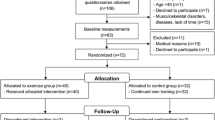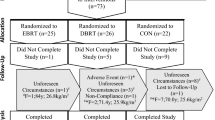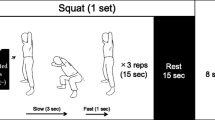Abstract
This study assessed the effect of unilateral strength training at 80% one repetition maximum and of detraining on bone mineral density (BMD, g/cm-2) and bone mineral content (ΣBMC, g) in young women. Twelve female physiotherapy students trained their left limb by leg press an average of four times per week for 1 year followed by 3 months of detraining. Twelve students served as controls. Repeated bone measurements were performed by dual energy X-ray absorptiometry of the lumbar spine, femoral neck, distal femur, patella, proximal tibia, and calcaneus. The training increased the muscle strength of the trained limb, and the BMD of the same limb showed a nonsignificant but systematic increase in distal femur, patella, and proximal tibia, and in ΣBMC of the five measured limb sites (considered an index of the total osteogenic effectiveness of the training). Simultaneously, the muscle strength increased in the untrained limb as an evidence of cross-training effect. A corresponding small but systematic increase was also seen in BMD of this limb as well as in ΣBMC. After the cessation of training, leg extension strength was retained but BMD and ΣBMC of the trained and untrained limbs declined towards baseline values in 3 months. The BMD and ΣBMC values in the control group showed an increasing tendency during the follow-up but the changes were less than 1%. The differences of the changes in BMD and ΣBMC between the left and right limb in the control group, as well as between the same limb in the training and control groups were nonsignificant. The findings of this study indicate that unidirectional strength training, intensive enough to induce substantial strength gain, is not an effective stimulus to increase BMD and BMC in young, physically active women. The unilateral training model turned out to be feasible in these subjects, producing a definite cross-training effect in muscle strength and a trend of similar effect in BMD. Further development of the unilateral training model, and studies to test if training produces adaptation in nonloaded bones (i.e., a crosstraining effect), are also warranted.
Similar content being viewed by others
References
Rubin CT, Lanyon LE (1984) Regulation of bone formation by applied dynamic loads. J Bone Joint Surg 66A:397–402
Frost HM (1992) The role of changes in mechanical usage set points in the pathogenesis of osteoporosis. J Bone Miner Res 7:253–261
Lanyon LE (1990) Bone loading—the functional determinant of bone architecture and a physiological contributor to the prevention of osteoporosis. In: Smith R (ed) Osteoporosis LR Printing Services Ltd. London, p 63
Lanyon LE (1992) The success and failure of the adaptive response to functional load-bearing in averting bone fracture. Bone 13:S17–21
Granhed H, Jonson R, Hansson T (1987) The loads on the lumbar spine during extreme weight lifting. Spine 12:146–149
Heinrich CH, Going SB, Pamenter RW, Perry CD, Boyden TW, Lohman TG (1990) Bone mineral content of cyclically menstruating female resistance- and endurance-trained athletes. Med Sci Sports Exerc 22:558–563
Nilsson BE, Westlin NE (1971) Bone density in athletes. Clin Orthop 77:179–182
Virvidakis K, Georgiou E, Korkotsios A, Ntalles K, Proukakis C (1990) Bone mineral content of junior competitive weight lifters. Int J Sports Med 11:244–246
Heinonen A, Oja P, Kannus P, Sievänen H, Mänttäri A, Vuori I (1993) Bone mineral density of female athletes in different sports. Bone Miner 23:1–14
Peterson SE, Peterson MD, Raymond G, Gilligan C, Checovich MM, Smith EL (1991) Muscular strength and bone density with weight training in middle-aged women. Med Sci Sports Exerc 23:499–504
Pruitt LA, Jackson RD, Bartels RL, Lenhard HJ (1992) Weighttraining effects on bone mineral density in early postmenopausal women. J Bone Miner Res 7:179–185
Notelovitz M, Martin D, Tesar R, Khan FY, Probart C, Fields C, McKenzie L (1991) Estrogen therapy and variable-resistance weight training increase bone mineral in surgically menopausal women. J Bone Miner Res 6:583–590
Snow-Harter C, Bouxein ML, Lewis BT, Carter DR, Marcus R (1992) Effects of resistance and endurance exercise on bone mineral status of young women: a randomized exercise intervention trial. J Bone Miner Res 7:761–769
Huddleston AL, Rockwell D, Kulund DN, Harrison BR (1980) Bone mass in lifetime tennis athletes. JAMA 244:1107–1109
Jones HH, Priest JD, Hayes WC, Tichenor CC, Nagel DA (1977) Humeral hypertrophy in response to exercise. J Bone Jt Surg 59A:204–208
Pirnay F, Bodeux M, Crielaard JM, Frachimont P (1987) Bone mineral content and physical activity. Int J Sports Med 8:331–335
Wolman RL, Clark P, McNally E, Harriers M, Reeve J (1990) Menstrual state and exercise as determinants of spinal trabecular bone density in female athletes. Br Med J 301:516–518
Kannus P, Haapasalo H, Sievänen H, Oja P, Vuori I (in press) The site-specific effects of long-term unilateral activity on bone mineral density and content. Bone
Angus RM, Sambrokk PN, Pocock NA, Eisman JA (1988) Dietary intake and bone mineral density. Bone Miner 4265–4272
Heinonen A, Sievänen H, Viitasalo J, Pasanen M, Oja P, Vuori I (in press) Reproducibility of computer measurement of maximal isometric strength and electromyography in sedentary middle-aged women. Eur J Appl Physiol
Sievänen H, Oja P, Vuori I (1992) Precision of dual-energy X-ray absorptiometry in determining bone mineral and content of various skeletal sites. J Nucl Med 33:1137–1142
Smidt GL (1973) Biomechanical analysis of knee flexion and extension. J Biomech 6:79–92
Hungerford DS, Barry M (1979) Biomechanics of the patellofemoral joint. Clin Orthop 144:9–15
Frost HM (1987) Bone “mass” and the “mechanostat”: a proposal. Anat Rec 219:1–9
Frost HM (1993) Suggested fundamental concepts in skeletal physiology. Calcif Tissue Int 52:1–4
Lanyon LE (1987) Functional strain in bone as an objective, and controlling stimulus for adaptive bone remodelling. J Biomech 20:1083–1093
Rubin CT, Lanyon LE (1987) Osteoregulatory nature of mechanical stimuli: function as a determinant for adaptive remodelling in bone. J Orthop Res 5:300–310
Whalen RT, Carter DR (1988) Influence of physical activity on the regulation of bone density. J Biomech 21:825–837
Turner CH (1991) Homeostatic control of bone structure: an application of feedback theory. Bone 12:203–217
Kannus P, Alosa D, Cook L, Johnson RJ, Renströn P, Pope M, Beynnon B, Yasuda K, Nichols C, Kaplan M (1992) Effect of one-legged exercise on the strength, power and endurance of the contralateral leg. A randomized, controlled study using isometric and concentric isokinetic training. Eur J Appl Physiol 64:117–126
White MK, Martin RB, Yeater RA, Butcher RL, Radin EL (1984) The effects of exercise on the bones of postmenopausal women. Int Orthop 7:209–214
Smith EL, Gilligan C, McAdam M, Ensign CP, Smith PE (1989) Deterring bone loss by exercise intervention in premenopausal and postmenopausal women. Ann Intern Med 108:824–828
Brewer V, Meyer BM, Keele MS, Upton SJ, Hagan RD (1983) Role of exercise in prevention of involutional bone loss. Med Sci Sports Exerc 15:445–449
Krolner B, Toft B, Nielsen SP, Tondevold E (1983) Physical exercise—a prophylaxis against involutional vertebral bone loss. A controlled trial. Clin Sci 64:541–546
Aloia JF, Cohn SH, Ostuni JA, Cane R, Ellis K (1978) Prevention of involutional bone loss by exercise. Ann Intern Med 89: 356–358
Tommerup LJ, Raab DM, Crenshaw TD, Smith EL (1993) Does weight-bearing exercise affect non-weight-bearing bone? J Bone Miner Res 8:1053–1058
Dalsky GP, Stocke KS, Ehsani AA, Slatopolsky E, Lee WC, Brige SJ (1988) Weight-bearing exercise training and lumbar bone mineral content in postmenopausal women. Ann Intern Med 108:824–828
Lane NE, Bloch DA, Hubert HB, Jones H, Simpson U, Fries JF (1990) Running, osteoarthritis, and bone density: initial 2-year longitudinal study. Am J Med 88:452–459
Häkkinen K, Sinnemäki P (1991) Changes in physical fitness profile during the competitive season in elite bandy players. J Sports Med Phys Fitness 31:37–43
Häkkinen K (1993) Changes in physical fitness profile in female basketball players during the competitive season including explosive type strength training. J Sports Med Phys Fitness 33: 19–26
Snow-Harter C, Whalen R, Myburgh K, Arnaud S, Marcus R (1992) Bone mineral density, muscle strength, and recreational exercise in men. J Bone Miner Res 7:1291–1296
Elickhoft JA, Molzlyck L, Gallagher JC, Staczy DJ (1993) Influence of isotonic, isometric and isometric and isokinetic muscle strength on bone mineral density of the spine and femur in young women. Bone Miner 20:201–209
Dalsky GP (1987) Exercise: its effect on bone mineral content. Clin Obstet Gynecol 30:820–832
Häkkinen K (1989) Neuromuscular and hormonal adaptations during strength and power training: a review. J Sports Med 29:9–26
Author information
Authors and Affiliations
Rights and permissions
About this article
Cite this article
Vuori, I., Heinonen, A., Sievänen, H. et al. Effects of unilateral strength training and detraining on bone mineral density and content in young women: A study of mechanical loading and deloading on human bones. Calcif Tissue Int 55, 59–67 (1994). https://doi.org/10.1007/BF00310170
Received:
Accepted:
Issue Date:
DOI: https://doi.org/10.1007/BF00310170




